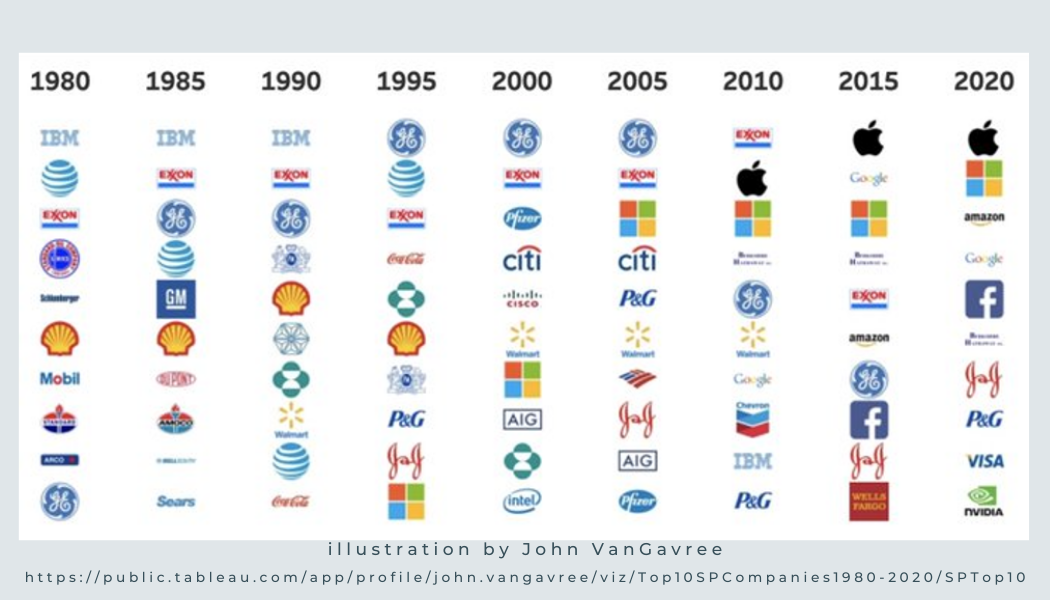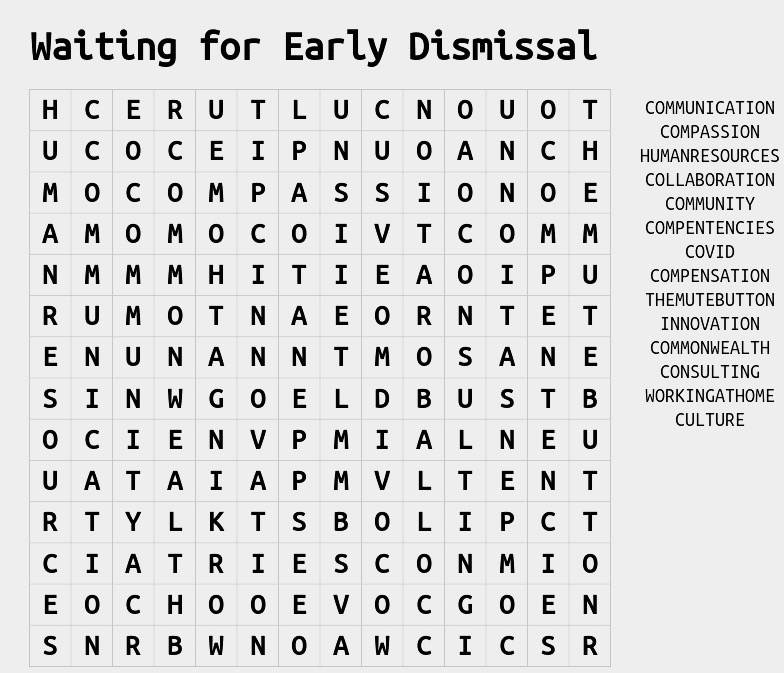
by Kate Evert | Nov 1, 2021 | Corporate Culture, Creativity at Work, Future of Work, Human Capital, Innovation, Leadership Agility, Performance Management, Performance Reviews
All the communal handwringing and bickering about: The Return to the Office
We’ve been using the wrong model.
HINT: think about the companies that dubbed their office “A Corporate Campus”
For those people that left home after high school to go away to college, what was the single most earth shattering change?
YOU DIDN’T REPORT INTO CLASS SEVEN OR EIGHT HOURS A DAY!
Prior to this, much of your success in education was tied to: showing up. If you didn’t, they called home. If you did this A LOT, there were meetings with your parents, or Saturday detention: [cue the Breakfast Club soundtrack now …]
Heck, the local government even paid people to be Truancy Officers and look for kids playing hooky.
Now, you get to your college and depending on the professor, they might not even take attendance. You might find out that there was absolutely no credit for attendance or participation.
As a lowly freshman, you got stuck with those 8 am classes MWF … or even worse, a 4 pm on MWF.
By the time you were a senior, you might have a seminar that met once a week. Once a week? In a small class where you only had, what 12 weeks to impress your professor? Nowhere to hide … had to have all that reading done …
You might find out that you had a class where 100% of your grade was how you did on the final exam.
So how did those professors know if you were doing your work?
- Did they stop by your dorm room at 2 am?
- Did they take attendance in the library? Know which carrel was your favorite and check to see if their text book was open and highlighted in the appropriate chapter for that week?
- In nice weather, did they stop by your spot on the lawn and make sure that you were reading text books?
- Did they attend parties or scour the local bars to make sure that your reading was done for the next day?
Probably not.
They graded your papers and your tests.
They evaluated your performance.
How is this different from hybrid work?

by Kate Evert | Oct 12, 2021 | Corporate Culture, Creativity at Work, Future of Work, Human Capital, Human Resources, Innovation, Labor Markets, Leadership Agility, Management, Performance Management, Pivoting, Productivity
This chart is eye grabbing.
Most reading this blog will easily recognize the vast majority of these logos. You aspired to work at some, you DID work for some.
One logo immediately caught my eye. In my days as a credit analyst, I signaled they were facing headwinds. In return, I got an extreme dressing down. The summation of that boss’s lecture? They were one of the largest companies in the country so how could I possibly even think to suggest that they were anything but stable?
The companies that have fallen off of this chart have done so for various reasons, for some it was hubris, for others an inability to pivot, in other cases, tastes change. A lack of innovation led to the demise of many.
Just yesterday, Jack Kelly had a piece in Forbes about the ultimate innovation: tailoring jobs to the individual needs of the various workers. Given the current labor and talent shortage in the U.S., this is exactly the right sort of solution for many organizations.
When firms can keep a clear focus on the deliverable, the output, where or how something gets done is less important.
Kelly says:
Consider how much better work would be if managers held conversations with their team, actively listened to how they’d like to work and then designed the job around their needs. Morning people could start early. Night owls can begin later in the day.
I lived this. Over 20 years ago at PwC, we had a well-oiled team that knew each other’s bio-rhythms and peak productivity hours. We joked that there were probably only three hours that someone from our group wasn’t awake and available; one person was an extreme lark that got into the office at 5:00 am, while another was such an extreme night owl that we regularly got emails from him at 2:00 am, working remotely. That is when I started experimenting with working from home … which one secretary dreaded because in uber-efficiency mode I banged through my To Dos, which then required her involvement.
As so many HR experts have reiterated: there are two ways to measure performance – inputs and outputs. Do you want to measure the hours that you see someone in (or their jacket on) their chair? Or do you want to measure what they deliver? The RESULTS.
Go back to that left hand side of the graphic. What happened to the temples those companies built? Big Stan in Chicago? GE Headquarters in Connecticut? The Sears Tower? They filled up with employees each morning and emptied every night.
Big buildings don’t matter. That S&P graphic is based on results.

by Kate Evert | Sep 21, 2021 | Agility, Corporate Culture, Creativity at Work, Diversity, Human Capital, Inspiration, Leadership, Management
We were pretty late to the game.
A sports-mad 21-year-old kept recommending this show about soccer … so you’re a bit skeptical.
But once the friend that actually went to a Premier League match with you decades ago, tells you that you MUST watch it, you actually do.
Luckily we binged shortly before the Emmy’s so were all caught up and understood why Ted Lasso deserved all the raves.
You can experience this series on so many levels. If you like football, or programs about sports and coaching, it is great entertainment. It also proves that once again, sports remain a wonderful arena for Management 101. If you’ve lived or traveled overseas and tried to adapt to a different culture, there are some overt and some subtle chuckles. Given the international nature of the sport, the team that Ted takes on is a perfect example of how complex global organizations are: not only are there personalities to manage, but personalities layered with national … proclivities.
What all the characters and story lines underscore is that there is no one perfect way to motivate everyone, and that the best coaches and managers take the time and the effort to understand how best to inspire the individuals on their team. With so many leadership lessons from Lasso, some beat me to it. Late to the game, I tip my hats to them, and share their insights Read more here and here.
The agility in Ted Lasso is not just on the pitch. If you scan a few articles, you will discover that the lines between creators, writers, and producers blur. Brett Goldstein, who received the Emmy for best supporting actor, began as writer and ended up auditioning for a role. Not unlike the sport at its center, the show scores because the ensemble relies on assists. When teammates are generous with each other, they are willing to make that extra pass, to get a better line, to set up for a surer goal, and a better ending.

by CHRC | Jan 5, 2021 | Creativity at Work, Human Capital, Innovation, Inspiration, Productivity, Skilled Labor, Strategy, Work Place
Over the holidays, I hung out with one of my most inspirational friends from my adolescence. We spent many hours together reliving her many escapades (and the ways in which she inspired me to ride along on her adventures), even though I will never be as brave as she is. We even giggled about her hairdos and fashions. Don’t worry, we were socially distant the whole time—Nancy Drew was safely ensconced in the covers of her mysteries that made up this year’s holiday puzzle.
Unlike last year’s ridiculous puzzle undertaking, this year’s was not frustrating—it was fun. While no one else in my family helped, many other things did help with this puzzle. Intimately knowing the artwork of many of these covers, the ability to discern the difference between fashion across the decades, and then of course, an eye for fonts.
At some point in the endeavor, I was struck by a thought that differed from last year’s insight. It was at the point when you have done enough of the hard work that you notice a piece, recognize the color scheme or font, and remark, “Oh, I know where this belongs.” I started thinking about the types of Aha! moments that only come from long hours and deep thinking—a shortcut won’t get you there. It is only from studying something and understanding its nature, from having the patience to get to that point, that you can make a break-through. My mind immediately went to the scientists who developed the Covid vaccines in record time. They have spent careers doing the equivalent of 20,000 piece jigsaw puzzles. Their knowledge base far exceeded color schemes and fonts, but at the core of the development, patience.
So, I spent the rest of my time with Nancy pondering patience. What in our lives today (pre-Covid) fosters patience? In an age when many kids grow up with knowledge, entertainment, and transportation, amongst other things, at the tip of their fingers, how do we impart the value and lessons of patience to them?
We should all be extremely grateful to all the scientists who developed the Covid-19 vaccines in record time. Their patience and deep thinking was the key to solving the world’s biggest challenge.

by CHRC | Dec 22, 2020 | Community, Creativity at Work, Innovation, Leadership, Sacrifice
I don’t know about you, but the last time I had this feeling about a year ending was probably 4th or 5th grade. In grade school, some of your personal heroes were the room mothers. They showed up at key dates: Halloween, the last day before winter vacation, and Valentine’s Day. I associate room mothers with sprinkles, you know the kind you find on cupcakes or amazing sugar cookies.
But the most important day that they refereed was that last day of school before winter break. Because the only thing that stood between a bunch of kids getting out of school for two whole weeks was that sugar infused party, complete with sprinkles.
Now this is when we take pity on any grade school teacher. Those poor teachers spent the entire morning trying to calm a class full of children that acted as though they had already ingested a container full of sprinkles before they even got to school. We wriggled in our seats, barely able to contain our excitement …. if it had snowed outside, the distraction reached new heights. So, in an effort to keep us in our seats those poor teachers, who we might add were completely exhausted from trying to teach an entire semester, thought that they would outwit us, by giving us games and puzzles instead of work to keep us occupied until those room mothers showed up.
We’d sit there with our pencils in our fingers and start on the worksheets. We quickly figured out the teacher had tricked us into doing some math before we could color in a winter scene, or do a word search to review our spelling words from first semester.
In tribute to all those teachers from our childhood, and all of those teachers who have been coping as best they can in the fall semester of 2020, here’s a word search in hopes that this just might distract you for just a couple minutes as you wait with fingers crossed, hoping that the principal will get on the intercom and let us out with early dismissal from this year.

by CHRC | Oct 29, 2020 | Covid-19, Creativity at Work, Hiring, Human Resources, Innovation, Management, Strategy
By Margaret Jungels
Halloween’s upon us, but it’s not just ghosts, ghouls, and goblins that are keeping us up at night. Even without Covid-19, these recent months of wildfires, social unrest, politics, hurricanes, and murder hornets are enough to push even the most zen among us over the edge.
To top it off, amidst all this uncertainty, it’s time to start planning next year’s budgets! How do you predict anything about next year while still in a year full of “unprecedented times”? What costume or cape can you put on to possibly help with this task?
Good advice for our kids, is good advice for all of us right now: focus on what you can control and things that matter.
As your leadership team contemplates 2021, the things that you can control, and the things that really matter, reflect on how you have been able to survive 2020—your employees and their ability to adapt, innovate, and pivot weekly, if not daily. So, when thinking about how to budget for salary increases in the coming year, what should you do? What can you do?
- You can put together a process. Document the process. If you have a process from a previous year, review it, update it, and share it with everyone who touches it—people managers, finance, HR, and payroll. Make sure that people know what is expected of them, remind them in advance of due dates, and update the plan as you go. (This you can control)
- There’s a lot to think about when determining how to allocate your salary budget. How have labor markets changed in the past year? Do some departments or roles compete for talent differently than others? Has Covid-19 created hot or hard to fill jobs? But beyond all this, the issue of pay equity is here to stay. Allocate your salary budget in a way that advances pay equity. Let an analysis of current pay equity direct your budget allocation and drive changes to the way you pay, develop, and promote. Even with a relatively small budget, you can make sure that pay changes are advancing pay equity. (This matters)
And even though the world seems topsy-turvy, there’s still a lot that hasn’t changed. According to Willis Towers Watson’s 2020 North American Compensation Planning Pulse Survey, 84% of companies plan to deliver their pay increases on schedule. And while some companies (approximately 35%) plan to lower salary increases next year, the survey predicts a 2.6% average salary increase for non-executives—not so far off previous years. According to PayScale Market Trends the Technology and Transportation sectors remain strong and lead annual increase trends, but most other sectors are still doing relatively well. In some cases, even in Entertainment and Hospitality who have seen many layoffs, market rates of those who remain employed have been driven up.
Finally, two things we can promise you—we’re here to help you navigate these tricky times, and, we’ll save you some fun-sized Kit Kats for when we can meet in person again!






